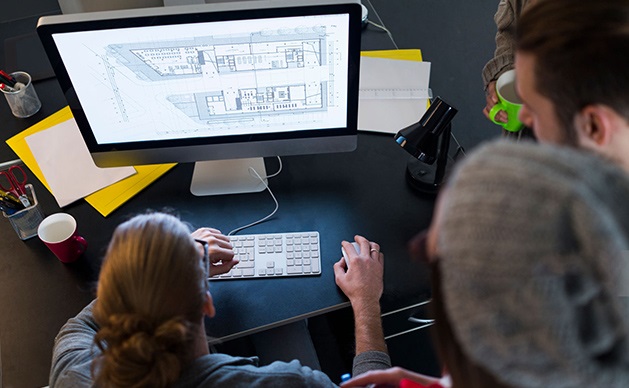For a long time, the Construction handover has always been a struggle. The information which is generated in the project is only partly relevant for operations. Also, a lot of new documentation has to be produced and collected for operational needs. This amount of work is usually left until the end of the project when deadlines are emerging and budgets are already spent.
These are the issues COBie addresses regardless of the stage of the owners/projects. O&M manual content and process-specific requirements are conveyed in the form of a well documented SOW, tailored to satisfy the Owner’s Facility Management (FM) needs. This step should be considered in the planning and design phases and is carried out in the construction phase. Here, COBie came at the front end of the project, helps in facilitating the entire process.
eLogicTech is an architectural, civil, structural, and BIM implementation service provider, we help construction firms, project teams, and architects implement COBie. We cater to our clients in developing BIM-specific processes & workflows to enable them in the effective implementation of BIM methodologies in their projects.
What Is COBie in the Context of the AEC Industry

‘COBie’ stands for Construction Operations Building Information Exchange, is a United States-based specification used to manage the asset information that includes space, equipment, and it is used to organize construction project information. It aims to pull the information into one format and share it between the construction team at defined stages in a project.
‘COBie’ is highly used in the product data handover from the construction team to the operations team.
How to Implement COBie
The COBie toolkit has a very straightforward workflow. Firstly, one needs to set up a project with contact information and configure the parameters, then we modify the object associated with the COBie elements to support the COBie requirement.

Finally, we export the info from the web model in the COBie format. The COBie is implemented in the following toolkit workflow:
1. SETUP
One needs to create and manage the contact records for the individual associated with the COBie project
2. MODIFY
We began with organizing Revit room and spaces into COBie zones. This is done with the new COBie zone manager which is included as a part of the COBie tool kit. Design managers provide for the creation and maintenance of COBie zones within the Revit model. Providing an interface to add spaces to one or more designs.
We use the element selection task, to identify what Revit elements are to be exported to COBie. The last step is to ensure that the information within the Revit model confirms the req of COBie.
This includes automatically populating certain fields req for COBie, transferring information into the appropriate COBie fields and ensuring that the info is properly formatted.
3. EXPORT
Where we select which COBie worksheets or tables are req to be exported and whether or not we need to create a new COBie workbook, this will be dictated by the phase of the project that you ran whether or not the data will be appended to an existing sheet.
Advantages of COBie Collaborative Platform
COBie has sparked up a new era of collaboration as an extension of BIM technology. By transforming the paper-based data storage method, COBie is finding its way to a new form of collaboration and information exchange across the industry. The benefits of COBie are mentioned below:
Efficient Data Management
the construction project cycle involves the production and exchange of a lot of data. That includes the BOQs, RFIs, various safety permits, documents from the planning department, etc. Here, ‘COBie’ plays a vital role in managing and organizing such data in a standard form.
Effective Data Sharing
COBie helps in information sharing among facility management tools like- BIM authoring tools, CMMS, etc. It cuts off the need for re-collecting data and the number of inaccuracies between corresponding data sets within a facility management organization.
Data Collection
Managers use the COBie standards for data collection before an upgrade of new construction maintenance software. There is no need to get a proprietary vendor spreadsheet to support data collection, and not to pay the CMMS vendor to map the in-house developed software spreadsheet.
Data Transfer
COBie has become the most effective method within the current construction industry state of affairs, to transfer construction data. It can export the construction information from BIM authoring tools and can import it into a COBie enabled CMMS resolution.
How Building Designers and Facility Managers Make Use of COBie

COBie makes the decision-makers aware of where assets are located and for the information, they need to be available. As COBie helps maintenance managers to understand when the warranty expires, what tools and parts are required to maintain the pump, the manufacturer, model number, etc, the whole maintenance job perfectly aligns to the timeline.
COBie organizes the handover data in a digital format, by which it becomes easier for owners and stakeholders like facility managers to review the construction handover documents. Stakeholders like – the designers, contractors and facility managers are benefitted from COBie specification.
COBie for Designers
COBie helps the designers to match their drawings with the COBie data, which includes the complied set of all the design schedules associated with all the drawings. It enables designers to directly export COBie data related to their drawings easily.
COBie for Contractors
COBie simplest the process for the contractors, to collate construction submission data effectively. Also, COBie makes helps in reducing the time and efforts spent on equipment surveys. COBie enables the contractors to automate the task of O&M manuals, by reducing their effort on compiling and organizing information for handover.
COBie for Facility Managers
COBie helps in accessing the documentation to the facility managers, occupants and owners, related to equipment and understanding spaces in detail. A well-organized COBie sheet makes facility managers easily take care of the building operations, management, and maintenance requirements throughout the entire lifecycle from the day of handover. So, now, it is no more required to go through that bulky and unorganized manual documentation once the stakeholders move on to COBie.
Leverage COBie with Expert Assistance from eLogicTech
An engineering workforce experienced in Architectural, Structural, and MEP, eLogicTech has the expertise and skillset to meet the demands of any complex project in the AEC space. Simplifying our services to match and adapt to the clients’ constantly evolving requirements, our project team has developed stringent processes to balance to price to quality ratio. Systematic knowledge sharing and perfection of the work process is an ongoing value add from eLogicTech that the clients can be benefited. Contact us for a personalized discussion and a custom quote today.







